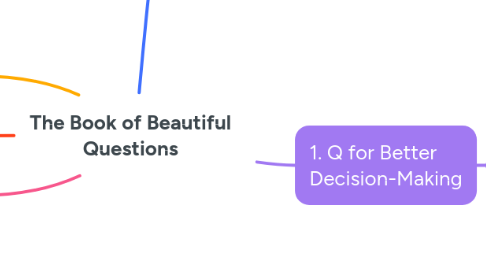
1. 4. Q for Stronger Leadership
2. 3. Q. to Help Connect with Others
3. 2. Q for Sparking Creativity
4. Introduction
4.1. Next level topic
5. 1. Q for Better Decision-Making
5.1. All purpose questions
5.1.1. How can I see this with fresh eyes? What might I be assuming?
5.1.2. Am I rushing to judgment?
5.1.3. What am I missing?
5.1.4. What matters most?
5.2. Check biases and beliefs
5.2.1. What am I inclined to believe on this particular issue? Start by trying to articulate your beliefs/biases.
5.2.2. Why do I believe what I believe? The “jugular question,” per Nobel Prize–winning physicist Arno Penzias, forces you to consider the basis of those beliefs.
5.2.3. What would I like to be true? A “desirability bias” may lead you to think something is true because you want it to be true.
5.2.4. What if the opposite is true? This question is inspired by “debiasing” experts and Seinfeld’s George Costanza.
5.3. Test your intellectual humility
5.3.1. Do I tend to think more like a soldier or a scout?
5.3.1.1. A soldier’s job is to defend, while a scout’s purpose is to explore and discover.
5.3.2. Would I rather be right, or would I rather understand?
5.3.2.1. If you place too much importance on being right, it can put you in “defence” mode and close off learning and understanding.
5.3.3. Do I solicit and seek out opposing views?
5.3.3.1. Don’t ask others if they agree with you — ask if they disagree and invite them to say why.
5.3.4. Do I enjoy the “pleasant surprise” of discovering I’m mistaken?
5.3.4.1. Finding out you were wrong about something needn’t be cause for shame; it’s a sign of intellectual openness and growth.
5.4. Detect Bull Shit
5.4.1. How strong is the evidence?
5.4.1.1. Critical thinking starts with demanding that there be substance behind any claim. A subset of “evidence” questions might include, Does this evidence come from a solid source? Is there an agenda behind it?
5.4.2. What are they not telling me? Sometimes the problem with information is not what is there, but what’s missing — whether it’s a news story with insufficient reporting or a sales pitch that leaves out important details.
5.4.3. Does it logically follow? When people are trying to persuade you, they may use flawed reasoning that suggests you should believe A because of B.
5.4.4. What is the opposing view? To avoid “weak-sense critical thinking,” be willing to seek out an opposing side of the issue you’re deciding on — and try to consider it with an open mind.
5.4.5. Which of the conflicting views has more evidence behind it? Go with the side that has more weight.
